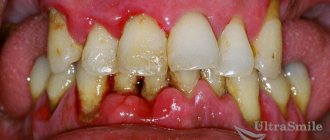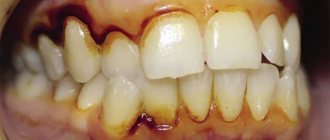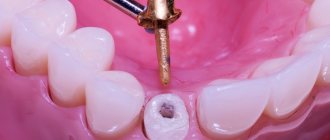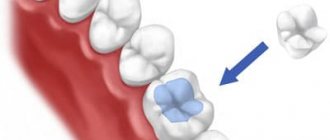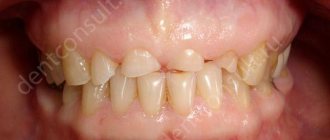When treating periodontitis, it is important to eliminate pockets of infection, strengthen weak gums and prevent further loosening of teeth. Conservative or surgical methods are used for this. The method of therapy depends on how far the inflammatory process has progressed. This is determined by the depth of the periodontal pockets and the degree of destruction of the bone tissue around the teeth.
Treatment of gums should begin at the first signs of inflammation. Long-term periodontitis can lead to exposure of tooth roots and even loss of healthy teeth.
Stages of periodontitis treatment
Competent treatment of periodontitis takes from 5 to 14 days and consists of the following procedures:
- X-ray diagnostics - allows you to determine the level of bone loss and the size of interdental spaces due to the lowering of the gingival margin.
- Removing microbial plaque - in 99% of cases, the cause of inflammation is bacterial deposits (sub- and supragingival), so treatment begins with eliminating the root cause.
- Local anti-inflammatory therapy - the use of antiseptics, antibiotics and non-steroidal anti-inflammatory drugs - Metrogyl denta, Ortofen, etc.
- Physiotherapeutic treatment of periodontitis - electrophoresis, darsonvalization and other physical methods that reduce the inflammatory reaction.
- General therapy - strengthening the immune system (vitamin therapy), taking antihistamines - Suprastin, Tavegil.
- Home care - use of toothpastes with enzymes and natural plant ingredients - Lacalut Fitoformula, Parodontol Active.
You can get rid of periodontitis once and for all only if you follow all the doctor’s recommendations. Self-medication is the cause of constant relapses.
Periodontitis is one of the dental diseases in which inflammation of the gums spreads to other periodontal tissues. Periodontitis destroys the dentogingival junction, and the bone tissue of the alveolar process and periodontium is also destroyed. Periodontitis is one of the main causes of tooth loss.
Signs of periodontitis:
The symptoms of the early stages of periodontitis development are characterized by the paucity of symptoms. Occasionally, while brushing your teeth, bleeding gums may appear, however, as a rule, people do not pay attention to this sign, and meanwhile the disease progresses. As it develops, other symptoms appear: the gums begin to redden and swell, and severe swelling appears. The necks of the teeth are exposed, the gums seem to be separated from the dentition. They are sensitive to the touch. Gaps form between the teeth, and pus begins to accumulate, hence the putrid odor from the mouth.
In a very advanced stage, the patient exhibits symptoms of general intoxication: body temperature rises, weakness and malaise occur, damaged teeth begin to fall out. Tooth pain is severe. Adjacent, healthy teeth may be involved in the inflammatory process. In this regard, the processes of chewing food are noticeably disrupted, and a colossal load is created on the digestive organs.
In case of untreated acute periodontitis, it takes a chronic form. Periodically, exacerbations occur, characterized by a sharp deterioration in the patient’s condition and the appearance of all the symptoms of acute periodontitis: the gums swell, redden, and purulent exudate appears.
The main causes of periodontitis:
1. Insufficient oral hygiene;
2. Presence of dental deposits (tartar and plaque);
3. Microorganisms and toxins produced by them;
4. Dentofacial deformation;
5. Unbalanced diet (lack of vitamins, calcium, fluorine, microelements in food, excess sugar in food and drinks);
6. Smoking;
7. Alcohol abuse;
8. Chronic diseases (diabetes mellitus, gastrointestinal diseases, etc.);
9. Stress;
10. Decreased immune system of the body.
Conservative methods of treating periodontitis:
At the initial stages, conservative methods of treatment for periodontitis are used, activating local blood circulation (various types of massages and physiotherapy), removal of tartar, professional oral hygiene, various orthopedic measures, including dental prosthetics. At the same time, medicinal treatment is carried out, including vitamin therapy and hormonal drugs.
Surgical treatment of periodontitis:
Surgical methods for the treatment of periodontitis include closed and open curettage , flap surgery , as well as a number of preventive surgical interventions, such as plastic surgery of the vestibule and frenulum of the lip and tongue . Closed and open curettage are effective interventions for less severe forms of periodontitis and consist of clearing interdental spaces from inflammatory tissue, treating the root surface and removing deep subgingival deposits.
In the advanced stage, treatment of periodontitis requires significant effort, time and money. But severely advanced periodontitis is almost impossible to cure! Therefore, it is so important to promptly consult a doctor when the first signs of periodontitis appear and find out which treatment method is right for you!
Treatment methods for periodontitis
Vector therapy
A universal method that is prescribed both at the initial stage of inflammation and for chronic periodontitis. It is carried out using the Vector ultrasound machine. A special scaler attachment creates ultrasonic vibrations that cleanse the gum pockets of toxins and pathogenic bacteria. As a result, the gums become denser, bleeding and suppuration stop.
One session of Vector Therapy is enough; it is recommended to repeat the procedure after 6 months.
Laser treatment of periodontitis
Painless and most effective procedure. The laser beam completely removes tartar, pus and soft plaque from the periodontal space. The biofilm where colonies of pathogenic microorganisms live is destroyed. In addition, the laser polishes the enamel, and fewer bacteria accumulate on the smooth surface.
A positive result is achieved after the first procedure
General principles of complex treatment of periodontal diseases
Treatment procedures for periodontal diseases are carried out taking into account the individual characteristics of the patient, based on diagnostic data about the local (direct periodontal tissues) and general status (condition of the body).
For a lasting positive result in treatment, methods are used that are aimed at different parts of the pathological process - an integrated approach is used.
Therapy for almost every periodontal disease includes:
- relief of disturbing symptoms (pain, unpleasant odor, discomfort);
- normalization of tissue condition through local use of medications (applications, injections) or appropriate corrective measures (surgery, grinding, bite correction);
- impact on the body as a whole.
Diseases of periodontal tissue include gingivitis, periodontitis and periodontal disease. These conditions differ in the nature of the pathological process, its prevalence, severity of symptoms, pathogenesis, which determines the necessary set of therapeutic measures.
One of the most important principles of treatment is an interdisciplinary approach, that is, close cooperation of specialists in related fields (periodontologist, orthopedist, surgeon, therapist, orthodontist).
The development of periodontal disease and periodontitis is often caused by chronic diseases, especially diabetes, blood pathologies, infectious and autoimmune diseases.
In such clinical cases, at the stages of diagnosis and dental treatment, the recommendations of the doctor treating the underlying disease (endocrinologist, therapist, oncologist) must be taken into account.
Surgical treatment of periodontal disease
Surgical intervention is indicated for severe periodontitis, when conservative methods have proven ineffective. The following operations are used:
- curettage – scraping of deep subgingival deposits with hand tools (hooks, excavators, curettes), carried out with or without opening the gums;
- flap surgery - a small incision is made near the edge of the gum, then the doctor moves the flap, removes the infected granulation tissue under the gum and eliminates periodontal pockets. After this, the wound is sutured;
- gingivotomy - removal of the inflamed and overgrown edge of the gum or gingival papilla. It is used to eliminate the source of infection, as well as for cosmetic purposes.
Surgical methods are painless as operations are performed under local anesthesia.
Surgical treatment
It is used when it comes to advanced, severe stages of chronic diseases.
Surgical methods:
- cleaning of periodontal pockets (curettage, gingivotomy, cryosurgery, gingivectomy, electrosurgery);
- performing patchwork operations to correct the gum edge and stimulate reparative processes in periodontal tissues.
- surgical formation of the vestibule of the oral cavity (anomalies in the location of the frenulum of the tongue and lip).
Most often, curettage of periodontal pockets is used, in which all pathological contents are removed from the pockets, due to which the pocket is significantly reduced in size, and the gum tissue fits more tightly to the neck of the tooth.
Flap operations in periodontics are also quite common. They allow you to correct the gum edge, which is extremely important, especially when treating hypertrophic gingivitis.
Treatment of tooth mobility in periodontitis
Orthopedic treatment
This is the final stage for those patients who are missing some teeth. The goal of orthopedic treatment is to restore chewing function, relieve increased mechanical stress in certain areas of the periodontium and prevent displacement of the remaining teeth. For this purpose, crowns, bridges, clasp or plate nylon prostheses are used.
Splinting
Dental splints are used to strengthen teeth weakened by periodontitis. These are thin fiberglass or metal wires that are fixed to the inside of the teeth.
First, the doctor makes a small groove in the enamel, then places a splint there and closes the top with special cement. The splint holds all the crowns together, eliminating their mobility. There are also removable types of splints.
Orthopedic treatment of periodontal diseases
Pathological processes in the periodontium can be caused by a violation of closure (occlusion) or the long-term absence of one or more teeth. In both cases, the distribution of the load that affects periodontal tissues during chewing changes.
For example, the periodontium in a certain area begins to experience overload when, after losing teeth, a person tries to chew food on one side.
To prevent or correct this situation, prosthetics are performed at any age - replacing lost or extracted teeth with artificial ones. Modern orthopedic dentistry has many types of prostheses - removable, fixed, based on implants and locking fastenings.
For periodontal treatment, correction of the closure of antagonist teeth (upper molar, premolar, incisor with the lower ones of the same name) is sometimes required. Grinding is carried out, during which the orthopedic dentist changes the shape of the occlusal surfaces of these teeth to achieve their normal (physiological) comparison.
After grinding, chewing efficiency is restored and chewing overload, which leads to chronic periodontal injury, is eliminated.
Periodontitis and its treatment
After 40 years, 30-40% of the population develops such an unpleasant disease as periodontitis.
It is an inflammation of the gums and ligaments of the tooth. Over time, the fibers connecting the tooth to the bone tissue and gums begin to break down, which leads to tooth mobility and its subsequent loss. The danger of this disease is that it inevitably progresses, and in a relatively short time (5-7 years) you can lose most of your healthy teeth. Therefore, doctors deeply study the question of how to treat periodontitis and develop effective methods for its prevention. Oral hygiene is of great importance in the development of periodontitis. In 70% of cases, the disease develops in people who neglect morning or evening brushing of their teeth and visit the dentist less than 6 months of age. As a result, tartar accumulates on the enamel, putting pressure on the gums and causing inflammation (gingivitis). If left untreated, this stage progresses to a more serious stage (with damage to the tooth ligament). The second cause is genetic predisposition, that is, if both parents had periodontitis, they are likely to pass this disease on to their child. In third place are general diseases and some conditions of the body (diabetes mellitus, variability, adolescence), during which hormonal changes occur.
